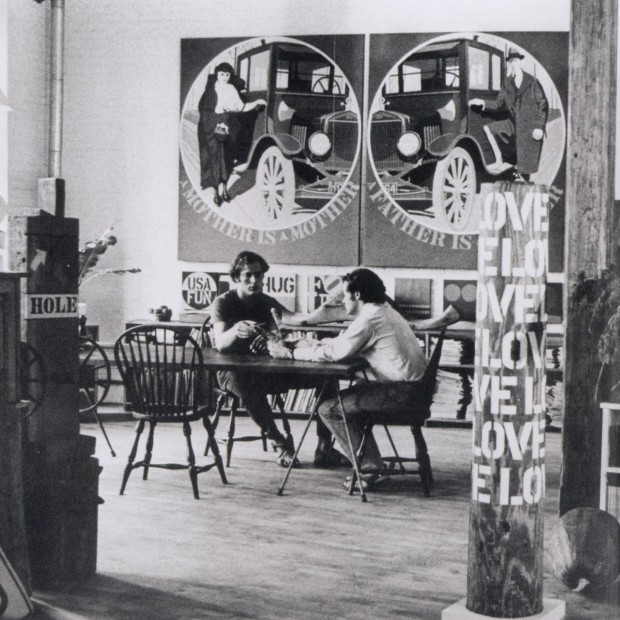Robert Indiana
-
-
“People don’t stop to think about how beautiful numbers are. Perhaps for the same reason that they don’t stop to think about how beautiful words are. […] It’s the role of the artist—my particular role, if you will—to make words and numbers very, very special.”
—Robert Indiana -
Paul Kasmin Gallery is pleased to announce the forthcoming solo presentation of sculpture by Robert Indiana. The exhibition, which honors the artist in his 90th year and celebrates over 15 years of representation by the gallery, will include two iconic works: LOVE WALL and ONE through ZERO.
-
Indiana’s archetypal stacked LOVE composition, with its bold serif lettering of VE stacked beneath the L and off-kilter O, is one of the most ubiquitous works of art of the 20th century. LOVE WALL (1966-2006) consists of four of Indiana’s classic LOVE compositions arranged in mirrored orientations with the four Os joined at the center, constructing an impressive 12ft high, Cor-ten steel monument. LOVE WALL is a monumental and superlative example of Indiana’s practice. Belonging to a series of iconic paintings, sculptures, and prints dedicated to the theme of love that the artist commenced in the mid-1960s, the work is both accessible and complex in meaning. Layered with personal references, erotic metaphors, religious underpinnings, and socio-political commentary—particularly as a symbol of 1960s idealism—Indiana’s use of the word LOVE goes beyond the confines of cultures and language.
Cor-ten steel, noted for its distinct rust color and durability, represents a particularly meaningful medium for Indiana. Initially developed for its industrial use, it was first employed by the artist in 1970 for his first monumental LOVE sculpture, which was installed at the entrance of Central Park in Doris C. Freedman Plaza and is now held in the permanent collection of the Indianapolis Museum of Art. Its inaugural presentation in New York marked a watershed moment for public art and generated universal enthusiasm for large-scale outdoor sculpture—the significance of which persists today.
Indiana’s impulse to appropriate industrial materials was influenced, in part, by the alternative zeitgeist of the rising generation of artists in late 1950s New York, who (whilst Abstract Expressionism was flourishing uptown) developed a burgeoning interest for a different kind of art in Lower Manhattan’s deserted shipping lofts at Coenties Slip. In his waterfront studio there, surrounded by relics of the old seaport including shipping equipment and metal stencils for signage from the seafaring days, Indiana began to incorporate the language and symbols that would become his signature elements. These new forms tapped into the American experience in a mode both immediate and poetic and further built upon questions of national identity as propositioned by American modernists such as Charles Demuth, Marsden Hartley and Edward Hopper—all of whom transformed the vernacular, including industrial sources, into fine art.
Indiana’s ONE through ZERO articulates the artist’s fascination with numbers as the most fundamental organizing principles of the world. “Numbers fill my life,” he has said. “We are immersed in numbers from the day we are born.” Comprised of ten individual sculptures, ONE through ZERO takes on a multitude of references that simultaneously hones in on autobiographical significances and conjures universal metaphors related to the sequential nature of life and death. Many of these references manifest in Indiana’s dramatic use of contrasting colors—an impetus that was heavily influenced by his close friend and peer Ellsworth Kelly. With ONE through ZERO, vivid greens, blues, yellows, reds and whites vie for attention, shining in high gloss, standing as pillars that the artist distinctly associates with the various stages of life from birth, infancy, youth and adolescence to the autumn of life, a sense of warning and ultimately the end of the cycle in ZERO.
Artwork © Morgan Art Foundation / Artists Rights Society (ARS), New York
-
About the Artist

-
Join our Newsletter
* denotes required fields
We will process the personal data you have supplied in accordance with our privacy policy (available on request). You can unsubscribe or change your preferences at any time by clicking the link in our emails.
-
Explore
-
Explore
- Diana Al-Hadid
- Alma Allen
- Theodora Allen
- Sara Anstis
- Ali Banisadr
- Tina Barney
- Judith Bernstein
- JB Blunk
- Mattia Bonetti
- William N. Copley
- Cynthia Daignault
- Ian Davenport
- Max Ernst
- Liam Everett
- Leonor Fini
- Barry Flanagan
- Walton Ford
- Jane Freilicher
- vanessa german
- Daniel Gordon
- Alexander Harrison
- Elliott Hundley
- Robert Indiana
- Lee Krasner
- Les Lalanne
- Matvey Levenstein
- Lyn Liu
- Robert Motherwell
- Jamie Nares
- Nengi Omuku
- Robert Polidori
- Jackson Pollock
- Elliott Puckette
- Alexis Ralaivao
- George Rickey
- James Rosenquist
- Mark Ryden
- Jan-Ole Schiemann
- Joel Shapiro
- Bosco Sodi
- Dorothea Tanning
- Naama Tsabar
- Bernar Venet


